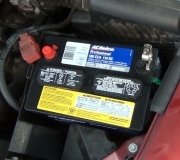Hi mdowdy227. Welcome to the forum. Testing for a drain on the battery has become very complicated because there are some computers that take up to a half hour to go to "sleep" mode. Instead, I think I would pursue your observation about where you're grounding the cable on the dead car. If you put the cable on a metal part of the body that isn't painted, you won't be able to get enough current for starting through the tiny wire that goes to the battery, however, you WILL get plenty to run the head lights and radio. It should also charge the battery enough to crank the engine if you leave it connected that way for ten or fifteen minutes. If everything is still dead, that would say there is no connection from the body to the battery negative in which case the head lights, tail lights, and everything inside the car would not work.
If you're connecting the ground cable to the engine and it is still dead, you simply are connecting to a dirty, rusted, or painted surface that is insulating it. For that to not work, the black negative battery cable would have to be defective and that would cause the starter to not work at all.
If there is a bad connection with the small wire that goes to the body, it could affect the operation of the generator which might lead to the battery not fully charging while driving. You could prove that by charging the battery with a charger on the lowest setting for a couple of hours, then letting the car sit unused. If it starts properly two weeks later, suspect a charging problem vs. A drain.
The industry standard is an unused car should start after sitting for three weeks. That pertains to a 35 to 50 milliamp (.035 amps) draw from the memory circuits for the radio and all of the computers. Some computers will draw up to three amps for up to a half hour after stopping the engine until they go to sleep mode. Simply disconnecting a battery cable to insert an ammeter, as we used to do, to test for a drain, will wake those computers and they will take another half hour to go to sleep. Even switching the scales on the meter will cause the computers to wake up again.
It's nice that you're following the directions when it comes to using jumper cables, but as a point of interest, there is nothing wrong with putting both negative cables on the batteries. The reason for putting one of them on the engine block is there will be a spark produced at the point where the last connection is made and you would like to have that not be near the vents on top of the battery. Batteries give off hydrogen gas. It is extremely rare for that gas to cause an explosion, but it's the "what if" principle. What if it does happen? I'm in the habit of blowing over the top of the battery just before I connect that last clamp, and I keep my face away from it too.
Once it's running, you can do a basic charging system test with an inexpensive digital voltmeter on the battery. You must find between 13.75 and 14.75 volts. If you still need to test for a drain, I can share the procedure I use. You will need that digital volt / ohm / ammeter, a jumper wire with clip leads large enough to attach to the battery post and to the battery cable clamp, and a pair of smaller clip leads to connect the meter leads to the battery post and the cable clamp.
Caradiodoc
Tuesday, November 23rd, 2010 AT 5:07 AM

